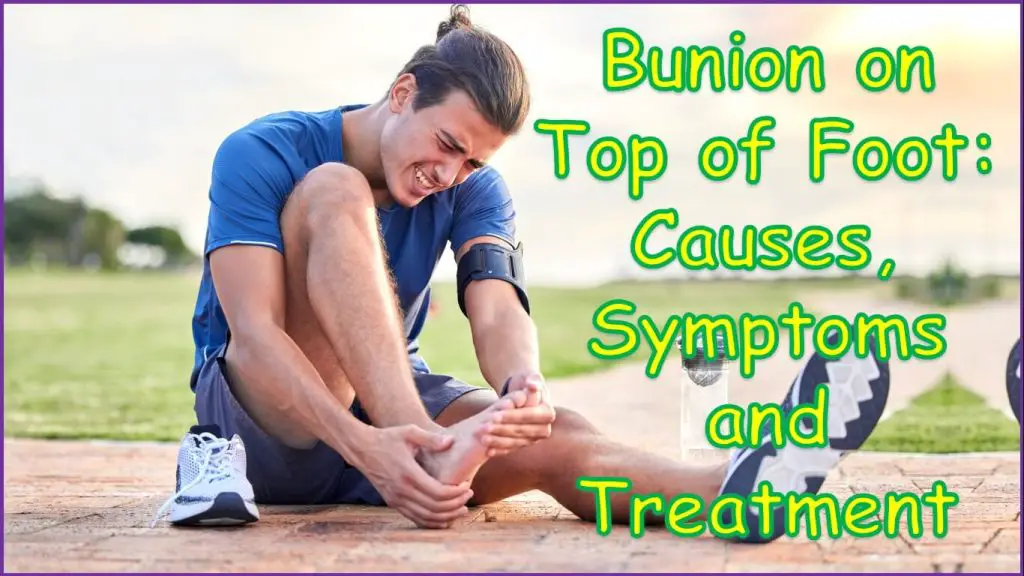Bunion on top of foot can give rise to agony and unease. Within this article, we shall examine the etiology, symptoms, and therapeutics concerning bunions atop the foot.
What Is Bunion On Top Of Foot?
A bunion is an osseous protuberance that takes shape upon the articulation of the base of the hallux. Nevertheless, bunions may also occur upon the articulation of the base of the fifth toe, commonly known as a tailor’s bunion or bunionette. Bunions atop the foot occur once an osseous protrusion arises on top of the foot, situated superiorly to either the hallux or fifth toe articulation.
Causes of Bunion on Top of Foot
The occurrence of bunions atop the foot is generally caused by the application of pressure and rubbing on the foot. The source of such pressure may arise from inadequately fitting shoes, high heels, or shoes that are too snug. Gradually, this pressure can lead to the alteration of the foot’s bones, culminating in the development of a bunion.
Symptoms of Bunion on Top of Foot
A common symptom of a bunion atop the foot is a visible protuberance located superiorly to either the hallux or fifth toe articulation. Additional symptoms may include:
- Pain or soreness in the afflicted area
- Swelling surrounding the affected joint
- Redness or inflammation encircling the affected joint
- Limited range of motion in the affected joint
Treatment Options for Bunion on Top of Foot
Several therapeutic choices are available for bunions atop the foot, such as:
- Wearing properly fitting shoes: One of the most vital things you can perform to forestall and treat bunions atop the foot is to wear appropriately fitting shoes. Seek shoes with a broad toe box and short heels to diminish the pressure upon the foot.
- Utilizing padding or shoe inserts: Padding or shoe inserts can assist in reducing pressure upon the affected area and provide supplementary support to the foot.
- Ingesting painkillers: Over-the-counter painkillers such as acetaminophen or ibuprofen can aid in alleviating pain and inflammation that accompanies bunions.
- Physical therapy: Physical therapy may improve suppleness and range of motion in the affected joint, along with strengthening the muscles in the foot and ankle.
- Surgery: In dire cases, surgery may be required to excise the bunion and realign the bones within the foot.
Can Bunions Cause Pain on Top of Foot?
Bunions, an all-too-common foot issue, can be a real pain, quite literally, causing discomfort, inflammation, and even bony bumps that can form on either the joint at the base of the big toe or the little toe. Surprisingly, though, it’s the former that can cause the greatest trouble, as the pressure and friction caused by the bunion can easily shift the delicate bones in your foot, leading to aches and twinges on top of your foot that just won’t go away. If you’re one of the unlucky ones dealing with this frustrating ailment, it’s essential to seek professional help in order to explore the range of treatment options available to you.
Pain on Top of Foot after Bunion Surgery
It is common to experience some pain on top of the foot after bunion surgery. Bunion surgery involves the removal of the bony bump on the joint at the base of the big toe or the little toe, and sometimes the realignment of the bones in the foot. During the recovery period, it is normal to experience some discomfort, swelling, and pain in the affected area.
However, if the pain on top of the foot is severe or does not improve over time, it is important to consult with a healthcare professional. This could indicate a complication or infection in the affected area, which may require additional treatment.
To manage pain on top of the foot after bunion surgery, your healthcare provider may recommend over-the-counter pain relievers, rest, ice, compression, and elevation of the foot. They may also recommend physical therapy exercises to help improve range of motion and strengthen the foot and ankle muscles.
Overall, while some pain on top of the foot is normal after bunion surgery, it is important to closely follow the post-operative instructions provided by your healthcare provider and seek medical attention if you experience any concerning symptoms or complications.
Conclusion
Bunion on Top of Foot can instigate pain and discomfort. However, various therapeutics are available. By wearing correctly fitting shoes, utilizing padding or shoe inserts, ingesting painkillers, and resorting to physical therapy or surgery if necessary, one may diminish pain and enhance foot well-being. If you suspect that you are experiencing a bunion atop the foot, consult with a healthcare professional to determine the optimal course of treatment tailored to your specific needs.
We hope you found this article informative and helpful. If you know someone who may benefit from this information, please feel free to share it with them. Additionally, we would love to hear your thoughts and experiences related to bunions and foot health. Please leave a comment below to share your feedback and join the conversation. Your input and insights could help others who may be struggling with similar issues. Thank you for taking the time to read this article and for considering sharing and commenting.
See Also:
- What is The Difference Between a Corn and a Bunion?
- Simple Foot Treatments to Make Feet Beautiful & Pain-Free
- 3 Bunion Surgery Myths You Should Know
- Lapiplasty vs Bunionectomy
- Why Do Some People Get Bunions?
- Best Sneakers for Ankle Support and Arch Support
- Bunion Pictures – Bunion Photo Gallery
- Busting the Bunions: 10 FAQs Answered
- Avoiding Problems After Bunion Surgery
- Factors to Consider: What Shoes Are Good for Bunions?
- Why do old people get bunions
